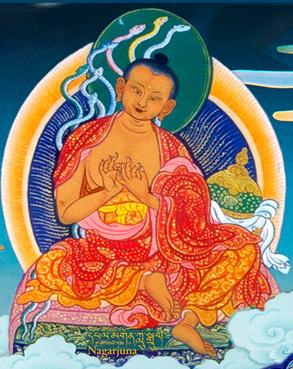Madhyamika: Difference between revisions
mNo edit summary |
mNo edit summary |
||
| (8 intermediate revisions by 3 users not shown) | |||
| Line 1: | Line 1: | ||
[[Image:Nagarjuna17.JPG|frame| | [[Image:Nagarjuna17.JPG|frame|Arya [[Nagarjuna]]]] | ||
'''Madhyamika''' (Tib. ''umapa''; [[ | '''Madhyamika''' (Skt. ''Mādhyamika''; Tib. [[དབུ་མ་པ་]], ''umapa''; [[Wyl.]] ''dbu ma pa'') — the followers of the '''Middle Way''' philosophy, which teaches freedom from all extremes. They say that just as truly existent external phenomena were refuted by the [[Chittamatra]] school, a truly existent perceiving mind must also be refuted, since both are equally lacking in inherent existence, being mere dependent originations. | ||
The Madhyamika school originates with [[Nagarjuna]], who commented upon the direct meaning of the [[Prajñaparamita]] sutras in his [[Collection of Reasoning]], which includes the famous ''[[Root Verses on the Middle Way]]''. | The Madhyamika school originates with [[Nagarjuna]], who commented upon the direct meaning of the [[Prajñaparamita]] sutras in his [[Collection of Reasoning]], which includes the famous ''[[Root Verses on the Middle Way]]''. | ||
==Subschools== | |||
There are two ‘schools’ or streams within the Madhyamika: the [[Svatantrika]] and the [[Prasangika]]. | There are two ‘schools’ or streams within the Madhyamika: the [[Svatantrika]] and the [[Prasangika]]. | ||
| Line 13: | Line 13: | ||
*The other, [[Bhavaviveka]], thought it was acceptable to use what is called “autonomous syllogism” (''svatantra''). This approach is called '''svatantrika'''. | *The other, [[Bhavaviveka]], thought it was acceptable to use what is called “autonomous syllogism” (''svatantra''). This approach is called '''svatantrika'''. | ||
==Madhyamika or Madhyamaka?== | |||
There has been some disagreement in Western scholarship on the use of the terms Madhyamaka and Madhyamika. Great Sanskritists such as T. R. V. Murti, a member of the Sanskrit Commission set up by the Indian government in 1959, advocated the use of "Madhyamika" on all occasions. Others use [[Madhyamaka]] for the system and the texts, and Madhyamika for its advocates. | There has been some disagreement in Western scholarship on the use of the terms Madhyamaka and Madhyamika. Great Sanskritists such as T. R. V. Murti, a member of the Sanskrit Commission set up by the Indian government in 1959, advocated the use of "Madhyamika" on all occasions. Others use [[Madhyamaka]] for the system and the texts, and Madhyamika for its advocates. | ||
==Further Reading== | |||
*David Seyfort Ruegg, ''The Literature of the Madhyamaka School of Philosophy in India'', Wiesbaden: Harrassowitz, 1981 | |||
*[[Kangyur Rinpoche]], ''Treasury of Precious Qualities'' (Boston & London: Shambhala, 2001), 'Appendix 8'. | |||
==Internal links== | ==Internal links== | ||
| Line 20: | Line 24: | ||
==External links== | ==External links== | ||
* | *{{LH|topics/middle-way|Middle Way Series on Lotsawa House}} | ||
[[Category:Key Terms]] | [[Category:Key Terms]] | ||
[[Category:Schools and Lineages]] | [[Category:Schools and Lineages]] | ||
[[Category:Philosophical Tenets]] | [[Category:Philosophical Tenets]] | ||
[[Category:Madhyamika]] | [[Category:Madhyamika| ]] | ||
Latest revision as of 10:28, 14 September 2023

Madhyamika (Skt. Mādhyamika; Tib. དབུ་མ་པ་, umapa; Wyl. dbu ma pa) — the followers of the Middle Way philosophy, which teaches freedom from all extremes. They say that just as truly existent external phenomena were refuted by the Chittamatra school, a truly existent perceiving mind must also be refuted, since both are equally lacking in inherent existence, being mere dependent originations.
The Madhyamika school originates with Nagarjuna, who commented upon the direct meaning of the Prajñaparamita sutras in his Collection of Reasoning, which includes the famous Root Verses on the Middle Way.
Subschools
There are two ‘schools’ or streams within the Madhyamika: the Svatantrika and the Prasangika.
These two approaches came about when two Indian masters wrote slightly different commentaries to Nagarjuna’s Root Verses text.
- Buddhapalita insisted that the followers of Madhyamika should not make any independent assertions, but merely show the absurd consequences of holding to any extreme position. This approach is called prasangika, meaning “consequence”.
- The other, Bhavaviveka, thought it was acceptable to use what is called “autonomous syllogism” (svatantra). This approach is called svatantrika.
Madhyamika or Madhyamaka?
There has been some disagreement in Western scholarship on the use of the terms Madhyamaka and Madhyamika. Great Sanskritists such as T. R. V. Murti, a member of the Sanskrit Commission set up by the Indian government in 1959, advocated the use of "Madhyamika" on all occasions. Others use Madhyamaka for the system and the texts, and Madhyamika for its advocates.
Further Reading
- David Seyfort Ruegg, The Literature of the Madhyamaka School of Philosophy in India, Wiesbaden: Harrassowitz, 1981
- Kangyur Rinpoche, Treasury of Precious Qualities (Boston & London: Shambhala, 2001), 'Appendix 8'.